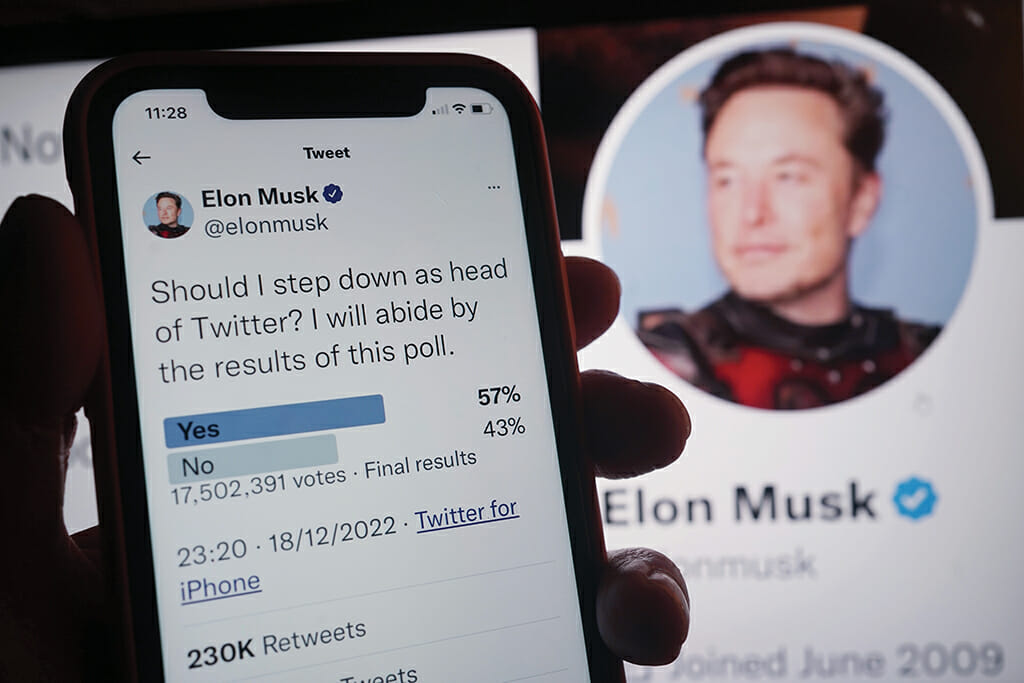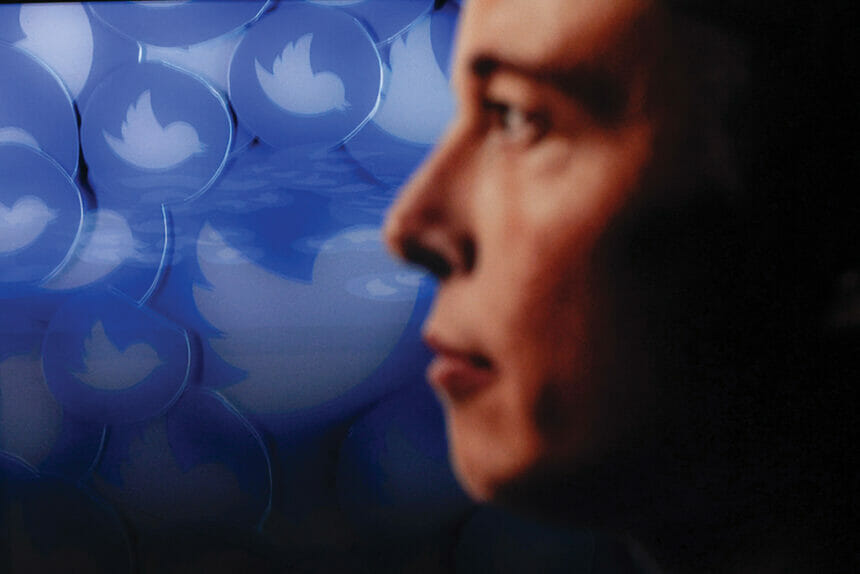To cover the day-to-day developments at Twitter in the wake of Elon Musk’s purchase of the company in October is a fool’s errand. By the time you read this, there will inevitably be yet another series of controversies regarding the platform’s functionality or content, or even the quirky billionaire owner himself.
The timing, at least for pharma, is less than ideal. Given the wild-west, anyone-can-say-anything-to-anybody feel of the platform’s first few years, it took some time before medical marketers mustered the confidence to establish a Twitter beachhead. But once they did, most were happy with the results. Between the ROI and the safeguards put in place to limit messaging proximity to certain terms or events, many brand marketers became Twitter disciples.
But with some of those guardrails obliterated in the Musk-era purge of critical Twitter personnel, marketers can no longer rely on the platform’s brand-friendliness. Case in point: Eli Lilly, which became one of the most prominent victims of New Twitter.
In November, an imposter armed with a company logo and the handle @ElilLillyandCo — and sporting a blue checkmark indicating “verified” status, courtesy of an $8 per month subscription to Twitter Blue — tweeted, “We are excited to announce insulin is free now.” Though the tweet was ultimately taken down, the damage was sudden and severe: It’s estimated the company lost billions in market cap in the days that followed. A Lilly rep declined to comment for this story.
That’s just one example of the complicated challenges brands face on Twitter. Marketers must also contend with the proliferation of questionable content following the company’s reversal of its COVID-19 misinformation policy and its restoration of accounts previously banned due to policy violations.
All of this prompts Smarty Social CEO Jami Eidsvold to characterize Twitter as “in flux.” She notes the platform’s uncertain future and its lack of trust among members of the medical marketing community.
It’s worth asking the question: Is Twitter, with its current baggage, still worth it?
On one hand, there are plenty of other options for eyeball-hungry marketers on social media. On the other, love it or hate it, there’s only one Twitter.
Competitors for pharma’s marketing spend include tried-and-true-but-sedate LinkedIn, Meta’s photo-focused Facebook and Instagram, and viral newcomer TikTok (which, it should be noted, could be banned by the federal government for its data practices by the time you read this).
Twitter is many things to many people, but there is a statistical argument to be made that the platform has peaked. Data from Demand Sage found that Twitter is the 14th most popular social media platform in the world. At the end of 2022, Twitter had 368 million active monthly users; that sum is expected to decrease to 353 million by the end of 2023 and to 335 million in 2024, according to Statista.

However, despite increased competition and declining metrics, Twitter remains a valuable platform for pharma marketers, owing in large part to its appeal to healthcare professionals. A report from ZoomRx indicated that, given Twitter’s popularity among physicians, pharma can’t simply abandon ship.
“Amidst the chaos and controversy, Twitter remains a vital resource to MDs for healthcare-related information,” the report reads. “Biopharma firms that manage to maintain positive relations with the #MedTwitter community, even during this chaos, would end up increasing their brand equity.”
An analysis by Vertic yielded similar results, finding that Twitter activity using two primary hashtags from a recent medical congress significantly increased in 2023 compared to 2021.
Given these dueling dynamics, medical marketers find themselves in a damned-if-you-do, damned-if-you-don’t situation. HCPs may choose to spend their time on any number of other social platforms, but on a basic level many of them like Twitter. So if pharma brands want to engage with those users, they have to be on Twitter.
Real Chemistry social media practice leader Eileen O’Brien believes that the conversational nature of Twitter lends itself easily to the exchange of ideas and scientific research among HCPs. She notes that while most brands have paused spending and haven’t committed to any kind of future relationship, it wouldn’t be wise for them to depart the platform entirely.
“They’re using Twitter for important business announcements. They’re reevaluating and they’re going to see what happens,” she explains. “Apple and Amazon have both reengaged on Twitter, so large companies are jumping back.”
The platform clearly wants these organizations to stick around. “Twitter is offering ad match spends,” she continues, adding that Real Chemistry is counseling clients to engage “based on the news it has to announce and in terms of how it feels about the reputational risks.”
There are other less visible benefits for marketers. Eidsvold notes that Twitter has a very open API (application programming interface), which makes monitoring campaigns and content easier than it is on other platforms. She acknowledges that it takes time and money to fully monitor social media activity for and about pharma brands, but that’s the price that comes with effectively reaching a target audience.
The bigger (and more prominent concern) is that pharma brands are not willing to put up with content and behavior that will endanger their bottom line. In recent months, they have displayed a willingness to vote with their pocketbooks. Following the Lilly fake-tweet debacle in November, many large pharmaceutical advertisers temporarily halted their Twitter ad spending, according to data from Pathmatics.
The cold-shoulder treatment didn’t last long. O’Brien noted that many life sciences brands remained active on Twitter after the Lilly incident — including Lilly itself. The fact that the company most severely affected couldn’t bring itself to quit the platform is proof of how reliant many brands are on Twitter.
That’s why brands need to engage across a range of platforms, rather than over-relying on Twitter. Matt Titus, VP and chief commercial officer at Epocrates, stresses that Twitter demands more scrutiny and a more strategic approach, given that the corporate reputations of these brands matter more now than ever.
A recent study by WE in partnership with Sapio Research found that HCPs rank corporate reputation as the second leading factor when it comes to prescribing decisions, behind a medication’s functional abilities. This comes as multiple surveys have shown that the goodwill showered on pharma and biotech brands during the pandemic has started to wane. That means effective communication with key stakeholders — especially HCPs — needs to be a top priority.
Another major point of contention for health-adjacent brands is New Twitter’s decision to scrap its COVID-19 misinformation policy. Restoring these limits, as well as reestablishing pre-Musk content moderation and safety features and creating a scientific advisory board, could serve to rejuvenate the trust pharma brands once had in Twitter.
“With some of the stuff Musk has taken away, it’s made this playground a bigger park for misinformation,” Eidsvold says. “If we’re going to get back to a place where pharma can trust Twitter again, it can’t be the playground or a free-for-all.”
Twitter did not respond to multiple requests for comment for this story. On March 19, it auto-responded to a final request sent to [email protected] with a poop emoji.
Media taunts notwithstanding, Megan Marrelli, editorial director at Meedan, a nonprofit that promotes digital literacy, states the obvious: There are consequences for allowing health misinformation to spread.
“The COVID-19 pandemic is an example of how health misinformation can actually spread real-world disease,” she explains. “One of the things that these advertisers are probably concerned about is placing themselves next to information that can cause real harm.”
Marrelli notes that pharma brands and medical marketers find themselves in a bind owing to a number of factors. While Twitter allows scientists and researchers to share data in a way that can’t be replicated elsewhere (or at least not at Twitter-level scale, anyway), the platform’s credibility has sagged due to the prevalence of misinformation. Thus, if Twitter wants to win back advertisers, she recommends that it refocus on providing legitimate content moderation. The platform might also invite researchers to join the company in an advisory capacity and offer greater transparency about its algorithm.
It should also be noted that, throughout the dramatic changes to Twitter in recent months, members of #MedTwitter conducted themselves with class and aplomb. Titus has nothing but praise for those individuals, who created a safe space for scientific dialogue while managing to block out the relentless noise reverberating throughout the platform.
As for what comes next, no one seems sure. Twitter could continue to see its functionality falter, prompting users to leave in dribs and drabs — a death by a thousand paper cuts rather than the mass exodus to another platform, such as Mastodon, that many observers initially predicted.
Marrelli notes that while some users have decided that “Twitter is not the place,” they might want to heed the oft-stated “grass is always greener …” proverb.
She believes that a decentralized Twitter replacement could open a Pandora’s box of unintended consequences related to content moderation and the spread of health misinformation. She likens the situation to choosing between a fixed-rate mortgage — that would be Twitter, warts and all — and an adjustable-rate one.
One development on the horizon is the appointment of a new Twitter CEO. In theory, Musk’s replacement would run day-to-day operations and, in so doing, run the platform in a manner that would restore trust among users and brands.
Titus predicts that within the year, a handful of social media upstarts will seek to claim Twitter’s throne. But until those other platforms emerge and prove their media mettle — quite the longshot in this media environment — HCPs will likely remain on Twitter. And by extension, so will many pharma brands.
“#MedTwitter is stuck with Twitter,” Titus says. “There is not an equivalent where they can go and have that scientific exchange. Until a newer, better version of Twitter comes along, there will continue to be that hardcore scientific exchange among clinicians, which is good for medicine.”
From the April 01, 2023 Issue of MM+M - Medical Marketing and Media







